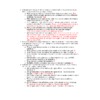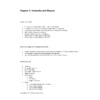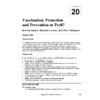|
|
Search Resources (7 Results)
 |
|
Lecture Notes | Approved: 4 years ago | 41.83 kB | Comments: 0
...A large protein antigen generally can combine...
...responsiveness to an antigen. True d. T-cell...
...T-cell receptor. False...need antigen processing to make...
...of a protein antigen. True...they could also...
...hapten is an antigen but not an...
...Immunogenicity of an antigen depends on the...
...immune response. An antigen is an agent...
...within a large antigen. a. They almost...
...of a protein antigen. T c. They...
...of a protein antigen. B d. They...
...when a protein antigen is denatured by...
...in the same antigen. BT 3. Indicate...
...to encode the antigen- specificity. 5. Where...
...less presentation of antigen. 20. Summarize the...
...between the terms antigen- presenting cell and...
| N/A |
56
|
farhan ali
|
 |
|
Lecture Notes | Approved: 6 years ago | 47.56 kB | Comments: 0
...is called an antigen. Antigens include molecules...
...way that an antigen elicits an immune...
...called antibodies. Each antigen has a particular...
...their plasma membrane-bound antigen receptors. Antigen receptors...
...membrane-bound antigen receptors. Antigen receptors on a...
...membrane immunoglobins). The antigen receptors on a...
...100,000 receptors for antigen, all with exactly...
...body, each bearing antigen receptors of particular...
...combat the same antigen. The other clone...
...for the same antigen. In this process...
...clonal selection, each antigen, by binding selectively...
...to eliminating that antigen. The selective proliferation...
...exposed to an antigen is the primary...
...cells clear the antigen from the body....
...to the same antigen at some later...
...affinity for the antigen than those secreted...
...contact the same antigen. 3. Lymphocyte development...
...and thymus, their antigen receptors are tested...
...immune system. Through antigen presentation, an MHC...
...an intracellular protein antigen in its hammocklike...
...it to an antigen receptor on a...
...cells (TC) have antigen receptors that bind...
...These cells, called antigen-presenting cells (APCs) in...
...molecule) and nonself (antigen fragment) that is...
...by interactions between antigen-presenting cells (APCs) and...
...that a foreign antigen is in the...
...binding to the MHC-antigen complex on the...
...the class II MHC-antigen complex on an...
...that have contacted antigen differentiate into antibody-secreting...
...phagocytoses and presents antigen, the macrophage is...
...plus the presented antigen, activates the helper...
...a closer look Antigen-activated cytotoxic T lymphocytes...
...with class I MHC-antigen complexes on an...
...its target cell—the antigen-presenting cell—primarily by releasing...
...B cells bearing antigen receptors are selected...
...by the same antigen. These B cells...
...has two identical antigen-binding sites specific for...
...receptor for an antigen nor the secreted...
...to an entire antigen molecule. An antibody...
...portion of the antigen called an epitope...
...determinant. A single antigen, such as a...
...of an antibody’s antigen-binding site. Multiple noncovalent...
...form between the antigen-binding site and its...
...antibody specificity and antigen-antibody binding has been...
...epitope on an antigen. These have been...
...which it mediates antigen disposal. There are...
...antigens to form antigen-antibody complexes is the...
...basis of several antigen disposal mechanisms. In...
...activity of the antigen. For example, antibodies...
...at least two antigen-binding sites. IgM can...
...cross-linking of soluble antigen molecules—molecules dissolved in...
...complement fixation, the antigen-antibody system activates the...
...antibodies bound to antigen and is therefore...
...rather than acquired, antigen-specific mechanisms. However, some...
...recognized as an antigen by the “owner,”...
...blood cells. Neither antigen is found on...
...to the B antigen, even if the...
...another blood group antigen, the Rh factor,...
...eliminate the Rh antigen before her own...
...attach to the antigen-binding sites of mast...
...class II MCH-bearing antigen-presenting cells, but also...
| N/A |
137
|
Guest
|
 |
|
Outline | Approved: 7 years ago | 42.14 kB | Comments: 0
...syndrome (AIDS) allergy antigen autoimmunity B cells...
...cell B) an antigen C) complement D)...
...exposure to an antigen before it can...
...protection against any antigen. Answer: True Objective...
...exposure to an antigen triggers cell-mediated immunity....
...to the same antigen. Answer: False Objective...
...A normally harmless antigen that causes an...
...immune system. Answer: antigen Objective 1 3)...
...antibody or the antigen. Answer: immunoassay Objective...
...to a harmless antigen. Answer: allergy Objective...
...protection against any antigen. Once the adaptive...
...responds to an antigen, the body is...
...of the same antigen. Nonspecific immunity prevents...
...response to an antigen. Crosses the placenta...
...response to an antigen. Activates complement. IgA:...
...activated by an antigen that was engulfed...
...encounter a new antigen, the body is...
| N/A |
381
|
Guest
|
 |
|
Other | Approved: 7 years ago | 192.2 kB | Comments: 0
| N/A |
166
|
gideoq
|
 |
|
Outline | Approved: 7 years ago | 177.5 kB | Comments: 0
...is called an antigen. Most antigens are...
...cell has many antigen-specific receptors embedded in...
...about 100,000 identical antigen receptors. B cells...
...form of the antigen receptor. This secreted...
...portion of an antigen called an epitope...
...determinant. A single antigen usually has several...
...epitope on an antigen. Each B cell...
...receptor for an antigen is a Y-shaped...
...has two identical antigen-binding sites formed from...
...receptor for an antigen consists of two...
...form a single antigen-binding site. The remainder...
...for presenting an antigen fragment to T...
...The process for antigen recognition by T...
...peptide antigens or antigen fragments. These peptide...
...surface, resulting in antigen presentation, display of...
...display of the antigen fragment on the...
...surface. If an antigen-presenting cell encounters a...
...bind the peptide antigen. Antigen presentation by...
...the peptide antigen. Antigen presentation by MHC...
...responses against an antigen and targets infected...
...cells displaying the antigen for destruction. The...
...that presents the antigen determines which response...
...pathogen displays an antigen, it signals the...
...response to that antigen and the pathogen...
...cell displays an antigen, it signals the...
...cell displaying an antigen, the immune system...
...cells, known as antigen-presenting cells, display antigens...
...response to an antigen that has been...
...the specificity of antigen receptors on lymphocytes....
...about 100,000 identical antigen receptors. It is...
...have the same antigen receptor. The variable...
...of a particular antigen receptor differ in...
...regions form the antigen-binding site, a particular...
...with a particular antigen-binding specificity. How do...
...remarkable diversity in antigen receptors? The answer...
...All B cell antigen receptor and T...
...and T cell antigen receptor genes undergo...
...genes have rearranged, antigen receptors can be...
...together, forming an antigen receptor. Each pair...
...in a different antigen-binding surface. For the...
...and tissues. Because antigen receptor genes are...
...or thymus, their antigen receptors are tested...
...enormous variety of antigen receptors, few are...
...on a given antigen. As a result,...
...rare for an antigen to encounter a...
...specific for that antigen. The binding of...
...binding of an antigen receptor to its...
...to its specific antigen initiates events that...
...short-lived, attack the antigen and any pathogens...
...that produce that antigen. Memory cells, which...
...specific for the antigen. The proliferation of...
...to binding an antigen is called clonal...
...presentation of an antigen to specific receptors...
...specific for that antigen. The production of...
...exposure to an antigen represents the primary...
...to the same antigen, the response is...
...exposure to an antigen. Because these memory...
...and when an antigen is encountered again,...
...specific for that antigen enable the rapid...
...by encounters with antigen-presenting cells, helper T...
...antigens displayed by antigen-presenting cells. The resulting...
...bind the peptide antigen that is held...
...molecule on the antigen-presenting cell. At the...
...cell and the antigen-presenting cell joined. As...
...principal types of antigen-presenting cells—dendritic cells, macrophages,...
...interaction with an antigen-presenting cell. Once activated,...
...activation by an antigen is aided by...
...encountered the same antigen. The B cell...
...The pathway for antigen processing and display...
...pathway in other antigen-presenting cells. A macrophage...
...presents only the antigen to which it...
...binds. When an antigen first binds to...
...then presents an MHC-antigen complex bound to...
...activation. A single antigen can provoke a...
...to a single antigen normally activates a...
...on the common antigen. A B cell...
...how it mediates antigen disposal. The five...
...antibody specificity and antigen-antibody binding has been...
...epitope on an antigen. Monoclonal antibodies are...
...basis of several antigen disposal mechanisms. In...
...bacteria. Binding of antigen-antibody complexes on a...
...blood cells. Neither antigen is found on...
...to the B antigen, even if the...
...attach to the antigen-binding sites of mast-cell–associated...
| N/A |
161
|
kelseymarkey
|
 |
|
Outline | Approved: 7 years ago | 147 kB | Comments: 0
...immune system to antigen(s) Autoimmune disorders (...
...into the body Antigen determinant site (...
...( portion of antigen that incites specific...
...immune system components Antigen encountered in body...
...cells ( foreign antigen stimulates lymphocytes, macrophages...
...macrophages to destroy antigen by phagocytosis Spleen...
...HIV Immunizations Introduce antigen into body (...
...causing clinical disease Antigen given in form...
...that have CD4 antigen Viral DNA integrated...
...response to an antigen that results in...
...to a client Antigen environmental, exogenous (...
...exogenous ( allergy, antigen allergen Response may...
...to a cell-bound antigen ( such as...
...ABO or Rh antigen Antibodies bind with...
...Antibodies bind with antigen ( complement cascade...
...by an exogenous antigen ( foreign tissue...
...( withdrawal of antigen stops hemolysis Type...
...exaggerated interaction between antigen, normal cell-mediated mechanisms...
...to an unidentified antigen causes aberrant immune...
...factor, human leukocyte antigen B27, antinuclear antibody...
...react with corresponding antigen ( form immune...
...factors Human leukocyte antigen genes seen more...
| N/A |
241
|
Guest
|
 |
|
Lecture Notes | Approved: 7 years ago | 1.66 MB | Comments: 0
...lymphoid cell lines Antigen-presenting cells (APCs) Operate...
...exposed to same antigen Proliferate rapidly, intense...
...On contact with antigen, activated and mature...
...complete antigens When antigen encountered in the...
...specifically to that antigen Takes 3 days...
...encounters with an antigen trigger memory cells...
...behaviors Immunizations Introduce antigen into body, allowing...
| N/A |
202
|
Guest
|
|
Post your homework questions and get free online help from our incredible volunteers
|